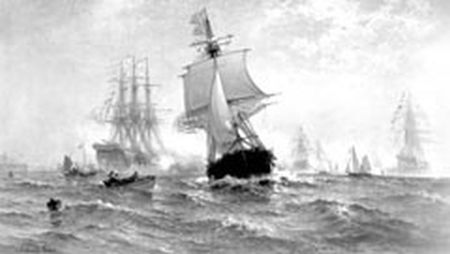American Revolution
See also: Guilford Courthouse, Battle of; Loyalists; Moore's Creek Bridge, Battle of; Resolves, Prerevolutionary; Rutherford's Campaign; Wilmington Campaign of 1781,U.S. Revolution, African Americans & the Revolution; American Revolution Bicentennial Observance; Daughters of the American Revolution; Reasons behind the Revolutionary War; Outfitting an American Revolutionary Soldier
Part i: Introduction; Part ii: First North Carolina Conflicts and the Establishment of a Provincial Government; Part iii: North Carolina's Role in the Continental Congresses; Part iv: Conflict with the Cherokees and British Invasion of the South; Part v: Gen. Nathanael Greene and the Battle of Guilford Courthouse; Part vi: A Troubled Aftermath; Part vii: References
Part I: Introduction
The American Revolution was fought on several critical battlefronts across North Carolina and near its borders, altering the lives of all North Carolinians and creating social and political upheaval within practically every community. The progression to full-scale war in North Carolina, as in other American colonies, was a slow process marked by years of emerging unrest among its citizens. Crises such as the violent resistance to the 1765 Stamp Act-as well as the adoption of anti-British documents, or "resolves," by some local political leaders who believed England's economic policies toward the colonies to be unfair and overly punitive-created a spirit of revolution well before any significant battles took place within the province. By the time war erupted after the bloodshed in Lexington and Concord, Mass., on 19 Apr. 1775, which left the British with 273 dead, wounded, or missing compared to 100 American casualties, many North Carolinians had already been anticipating the fight to gain their independence.
Keep reading > Part II: First North Carolina Conflicts and the Establishment of a Provincial Government![]()
Educator Resources:
Grade 8: “The Revolutionary Times” – News article assignment. NC Civic Education Consortium. http://civics.sites.unc.edu/files/2012/05/RevolutionaryTimesNewsArticleAssignment.pdf.
Grade 8: Revolutionary War People Project. NC Civic Education Consortium. http://civics.sites.unc.edu/files/2012/05/RevolutionaryWarPeopleProject.pdf.
Grade 8: American Revolution: Events Leading to War. North Carolina Civic Education Consortium. http://civics.sites.unc.edu/files/2012/04/AmericanRevolutionEventsLeadin...
Grade 8: On the Road to Revolution:Creating a Living Timeline. North Carolina Civic Education Consortium. http://civics.sites.unc.edu/files/2012/05/OntheRoadtoRevolutionLivingTim...
Grade 8: Edenton Tea Party. North Carolina Civic Education Consortium. http://civics.sites.unc.edu/files/2012/04/EdentonTeaParty.pdf
Grade 8: Revolutionary War Era Project. NC Civic Eduation Consortium. http://civics.sites.unc.edu/files/2012/05/RevolutionaryWarTickTackToeProject.pdf
Grade 8: Loyalists and Patriots. North Carolina Civic Education Consortium. http://civics.sites.unc.edu/files/2012/05/LoyalistsandPatriots.pdf
Grade 8: Mecklenburg Resolves. North Carolina Civic Education Consortium. http://civics.sites.unc.edu/files/2012/05/MecklenburgResolves.pdf
Image Credit:
"First Recognition of the American Flag by a Foreign Government, 14 February 1778, painting by Edward Moran, 1898." Photo courtesy of the State Archives of North Carolina, call #: N_71_3_9. Available from https://www.flickr.com/photos/north-carolina-state-archives/5622494530/ (accessed May 10, 2012).
1 January 2006 | Davis, David K.; Lamm, Alan K.; Whittenburg, Carolyn Sparks
